History of the PCC Overhaul Programs
Note: Click on the photos to see
enlargements with captions.
Scroll down to the bottom of this page to see more photos.
Keeping the PCCs on the Streets
By Rev. E. Casey
History of the PCC Overhaul Programs
Note: Click on the photos to see
enlargements with captions.
Scroll down to the bottom of this page to see more photos.
Keeping the PCCs on the Streets
By Rev. E. Casey
The rebuilding program of PCC cars commenced in 1973 when one air-car, 2565, and one electric car, 2168 were completely rebuilt. The rebuild included stripping the car to the bare frame and replacing all wiring. Two experimental paint schemes were applied to the cars. 2168 was painted lemon yellow, with a purple belt rail and a white top, earning it the nickname "banana car". 2565 was painted bright orange, with blue trim and a white top. Because of the similarity between these colors and those of a well known petroleum company, 2565 came to be known as the "Gulf Oil" car.
The two cars featured interiors of white and wood grained plastic laminate material, new incandescent lighting fixtures, lexan windows, orange brown tweed-like plastic upholstery and sheet linoleum flooring. These two cars did not have the bus horns, push doors or bus marker lights that would be applied to later experimental rebuilding projects. One significant change in this project was the removal of the old wood-slat lifeguard trip gates under the fronts of the cars. In their place, a plow-like device was fastened to the front of the front trucks.
The exterior and interior paint on the cars was bought from a company called Uracal Chemical Company and was supposed to be graffiti resistant. After a car was marred with scribbling, it was supposed to be sprayed with a special chemical and after the car went through the washer it would come right off. The results were less than spectacular and it seemed that the only thing that effectively removed graffiti was plain old elbow grease by shop personnel.
2565 was the first car completed. It was sent to Woodland Depot, where it was put into service on the same run on Route 13 each day: Run 503, Block Number 3. 2168 initially went into service at Luzerne Depot, but after a few months the cars switched depots, and became part of the general rosters of the respective depots.
The orange, blue and white paint
scheme was judged to be the better choice. Later in 1973 cars 2124 and 2100
also appeared in the "Gulf Oil" scheme. 2124 was only repainted and not rebuilt,
while 2100 was overhauled along with being repainted. The first two 2700 cars
in this program were 2795 and 2800. Both of these cars went into service at
Germantown Depot, but 2800 was eventually assigned to Woodland. For 2800 and
railbuffs alike, this was an unfortunate switch, based on the events of October
1975. 2800 was one of 60 trolleys destroyed in the disastrous Woodland Depot
fire. 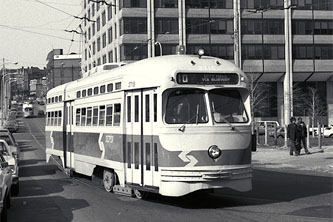
A new PCC rebuilding project was begun in 1979. This program was the most ambitious rebuilding program to date, and when looked at in retrospect, has to be considered fairly successful. The program was carried out with federal funds from the Urban Mass Transit Administration. The cost per car has been estimated at anywhere from $98,000 to $112,000, depending on the source of information. The rebuild was intended to add 8 to 10 years of useful life to the thirty year old cars.
Originally 50 cars went through the program at a cost of $ 3.94 Million. After the program was underway the program was expanded to a total of 112 cars. Only postwar all-electric cars (those built in 1947 and 1948) were to be included in the GOH program. The remaining air-cars, ex-Kansas City cars, and ex-Birmingham cars would be scrapped as soon as enough GOH cars were available for service.
2715 was the pilot car for the 1979 GOH program. This car was rebuilt from operating funds rather than the capital budget. The first car completed in the General Overhaul Program was 2100, which was assigned to Luzerne Depot in June of 1980.
The GOH cars were throughly rebuilt,
with replacement of deteriorated frame and body panels, complete rewiring, and
rebuilt trucks. The original roll-up windows operated by chrome cranks were
replaced with aluminum frame windows apparently sourced from school bus suppliers.
On the inside, flat aluminum panels replaced the original molded-in armrests
that had been a trademark of the post-war PCC. 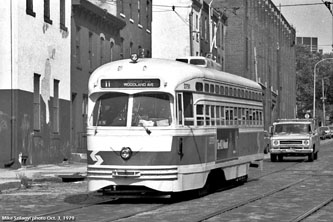
The new paint scheme for the GOH cars was basic white, with a stripe that included red and blue sections. There were two variations on the new paint scheme regarding the red stripe across the front of the vehicle. The first car painted in this new scheme, which was also being applied to SEPTA bus and trackless trolleys, was 2791 (which at the time, not a GOH car). The red stripe on the front of 2791 was applied below the front headlight. When 2715 came out of the shop, it also had the red stripe under the headlight. When 2100 was completed, the red band was applied above the headlight. This was judged to be the better looking option. 2715 was eventually repainted in the new pattern. The only other variation in this paint scheme throughout the 1980's was car 2730, which in 1989 received a paint scheme consisting of the same basic white with red / blue stripes, but with the entire side window area painted gray. The gray side window area scheme was similar that applied to the Neoplan diesel busses and the trackless trolleys at the time. Two Kawasaki trolleys also were painted with gray window areas.
2728 was the 100th car completed in the GOH program. This milestone was commemorated with a blue ribbon painted onto the side of 2728, designating it as the 100th car completed. 2728 was also permitted to retain its set of brass wings around the headlight.
The rebuilt cars were all placed in service on Route 56, until enough cars were available to be placed on the other lines. The last Luzerne line to receive the rebuilt cars was Route 23. Eventually Callowhill Depot received GOH cars for Route 15. Rebuilt cars in this program were never assigned to Woodland / Elmwood subway surface lines.
The newly rebuilt cars were part of a system wide plan of Quality Control established by then General Manager David Gunn. When the Gunn management took over in the late 1970s the equipment looked horrible. One of the first things that Gunn saw was the need to make the equipment look like you would want to ride on it. With many new vehicles scheduled to be acquired by SEPTA, including Neoplan busses, AM General trackless trolleys, and Kawasaki trolleys, Gunn wanted a program in place that would insure the new equipment would continue to look good.
Each car was inspected by the operator and a supervisor before it left the carhouse, and was re-inspected upon its return. If an operator made relief on the street, he or she was also expected to walk around and inspect the vehicle. Each vehicle had a diagram that depicted in graphic form the location of any physical damage, such as scrapes and dents. This was to be compared with what was found on the vehicle.
A car that had graffiti or any major body damage was not supposed to leave the depot. This was followed very strictly for the most part. The Quality Control Program had various growing pains in is method of operation in the early 1980s. However if you compare photographs of the cars taken during the 1970s with photos of the GOH cars taken toward the second half of the 1980s, the program of Quality Control instituted by the Gunn Management at SEPTA can be judged a success.
Enough cars were on hand to equip Route 56 when trolley service was restored in June 1980, because of decreased demand on Routes 23 and 50. Route 50 trolley service was suspended, and sewer work on the southern portion of Route 23 forced the temporary substitution of buses south of Erie Avenue.
The summer of 1980 also saw the West Philadelphia PCC cars converted to the trolley shoe method of current collection. This completed the conversion of the whole system from trolley wheels to trolley shoes.
-- Rev. E. Casey
These photos
by Harry Donahue. Click on them to view enlargements with captions.
![]()
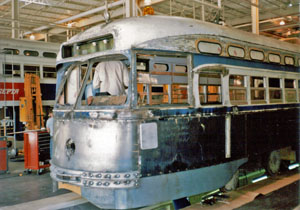
![]()
![]()
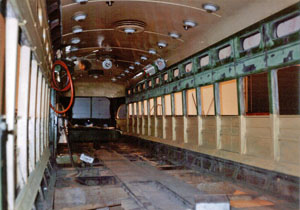
![]()
![]()
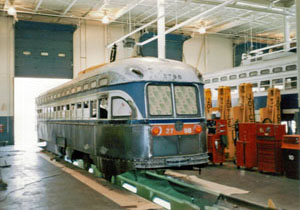
![]()
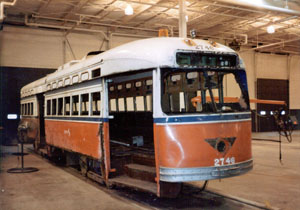
![]()
![]()
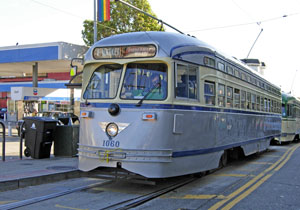
![]()
![]()
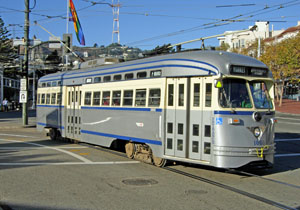
![]()
Return to Philadelphia Trolley
Tracks main page.